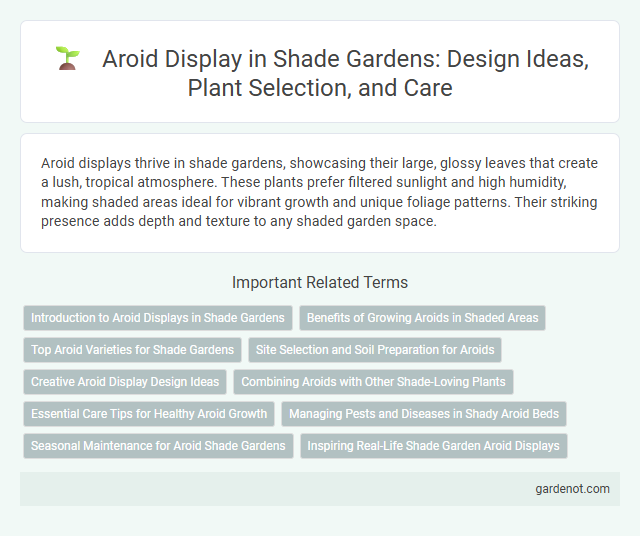Aroid displays thrive in shade gardens, showcasing their large, glossy leaves that create a lush, tropical atmosphere. These plants prefer filtered sunlight and high humidity, making shaded areas ideal for vibrant growth and unique foliage patterns. Their striking presence adds depth and texture to any shaded garden space.
Introduction to Aroid Displays in Shade Gardens
Aroid displays in shade gardens showcase the vibrant foliage and unique shapes of Araceae family plants like Philodendrons, Anthuriums, and Alocasias. These shade-loving species thrive in low-light conditions, creating lush, tropical aesthetics with their variegated leaves and striking textures. Emphasizing soil moisture and humidity control enhances the health and visual impact of aroid collections in shaded garden environments.
Benefits of Growing Aroids in Shaded Areas
Growing aroids in shaded garden areas enhances their vibrant foliage and unique textures by mimicking their natural tropical understory habitat. Shade reduces direct sunlight stress, preventing leaf burn and promoting healthier, more lush growth. These conditions also help conserve moisture in the soil, supporting the water needs of moisture-loving aroid species such as Anthurium, Philodendron, and Alocasia.
Top Aroid Varieties for Shade Gardens
Top aroid varieties for shade gardens include Philodendron hederaceum, Anthurium crystallinum, and Monstera adansonii, known for their lush foliage and adaptability to low light conditions. These aroids thrive under dappled sunlight, making them ideal for shaded environments while offering impressive leaf shapes and textures. Incorporating these species enhances shade garden aesthetics through vibrant greens and unique leaf patterns, promoting a tropical ambiance.
Site Selection and Soil Preparation for Aroids
Selecting a shaded site with filtered light is crucial for an optimal Aroid display, as these plants thrive under low to medium light conditions. Soil preparation should focus on creating a well-draining, aerated mix rich in organic matter such as peat moss, orchid bark, and perlite to replicate their natural forest floor habitat. Ensuring slightly acidic to neutral pH levels (around 5.5 to 7) promotes healthy root development and vibrant foliage in Aroids.
Creative Aroid Display Design Ideas
Creative aroid display design ideas emphasize layering diverse aroid species with varying leaf shapes, sizes, and textures to create visually dynamic shade gardens. Incorporating elevated stands or terrariums enhances depth and showcases unique foliage patterns like those of Anthurium, Alocasia, and Philodendron. Integrating natural elements such as driftwood or stone accents complements the tropical aesthetic and promotes healthy air circulation around the plants.
Combining Aroids with Other Shade-Loving Plants
Combining aroids with other shade-loving plants enhances texture and visual interest in a shade garden, as species like philodendrons, calatheas, and ferns complement each other's foliage. Planting aroids alongside hostas and astilbes creates a multi-layered effect, balancing broad leaves with feathery plumes. This strategic layering improves microclimate humidity and soil moisture retention, promoting healthier growth for all involved plants.
Essential Care Tips for Healthy Aroid Growth
Aroid plants thrive in shaded environments with indirect light, making shade gardens ideal for their display. Maintain consistently moist, well-draining soil rich in organic matter to support healthy root development and prevent waterlogging. High humidity levels between 60-80% and regular misting promote vibrant foliage, while balanced fertilization with a diluted, low-nitrogen fertilizer encourages robust growth without leaf burn.
Managing Pests and Diseases in Shady Aroid Beds
Shady aroid beds require vigilant management of common pests such as aphids, mealybugs, and spider mites, which thrive in humid, low-light conditions. Employing natural predators like ladybugs or applying insecticidal soaps can effectively reduce infestations without harming the delicate foliage. Regular inspection and maintaining proper airflow are critical to preventing fungal diseases like root rot and leaf spot, ensuring vibrant, healthy aroid displays in shaded garden areas.
Seasonal Maintenance for Aroid Shade Gardens
Seasonal maintenance for aroid shade gardens involves regular pruning to remove damaged or yellowing leaves, promoting healthy growth throughout the year. Maintaining consistent moisture levels and ensuring well-draining soil helps prevent root rot during wetter seasons, while adjusting humidity and light exposure supports optimal aroid performance. Monitoring for pests like spider mites and aphids during warmer months is crucial to preserving the vibrant foliage typical of aroid species in shady environments.
Inspiring Real-Life Shade Garden Aroid Displays
Aroid plants such as Philodendron, Anthurium, and Monstera thrive in shade gardens, creating lush, vibrant displays that inspire garden enthusiasts. Their variegated leaves and unique textures add depth and visual interest, making them ideal for low-light environments. Showcasing these diverse aroids in real-life shade garden settings highlights their adaptability and enhances garden aesthetics with tropical appeal.
Aroid display Infographic

 gardenot.com
gardenot.com